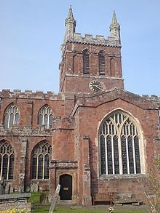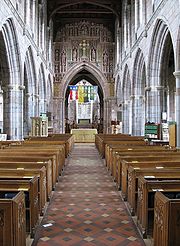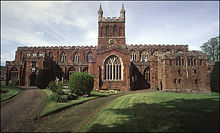
Crediton Parish Church
Encyclopedia
The Church of the Holy Cross
and the Mother of Him who hung thereon
(or Crediton Parish Church) is a prominent building and worshipping community in the Devon
town of Crediton
. The church was the cathedral of the Lord Bishop of Crediton
in the former diocese until 1050 when the See was transferred to Exeter. A College of Canons remained at Crediton, administering the buildings and life of the collegiate church. At the Reformation the church was surrendered to Henry VIII in 1545 and the college dispersed. The church buildings were bought by the Crediton Town Corporation who still administer the fabric today. Now a parish church, the life of the church is administered by the Parochial Church Council (PCC), although many still refer to the church as the Collegiate Church of the Holy Cross.
The Church is held in trust by the Governors of Crediton for the people of the parish, but its life and worship are planned by the clergy and Parochial Church Council (PCC).
Crediton had lost the see, but the Bishop of Exeter retained his palace there (a little to the north-east of Holy Cross) and his lands around the town. The church survived, though not in its original building. The construction of a Norman church on the present site was started—building work was in progress in the 1130s—and a collegiate church (initially staffed by 18 canons with 18 vicars) was established, although lack of funds meant that the number of canons was soon reduced to 12.
The collegiate church was always completely secular: none of the canons or vicars lived the communal life of monks, their work being funded by income from tithes on the extensive lands of the parish (which were shared with the bishop).
The early dedication of the church was to St Mary, but the present dedication—-the Church of the Holy Cross and the Mother of Him Who Hung Thereon—came into use only after the 1230s. The church was extended in the late 13th century by the addition of the Lady Chapel and the Chapter House.
John de Grandisson, Bishop of Exeter, (1327–1369) attempted to ensure that at least the chief officers of the college, the precentor and the treasurer, were resident in the immediate area of the church. Grandisson had enormous influence on the church in Crediton in another way. This was by introducing—or reviving—the cult of St Boniface (the cult of the saints was in full swing at this time) and firmly established Crediton as his birthplace. (A new statue of St Boniface was created in the 1970s by the sculptor Witold Gracjan Kawalec
).
In a medieval will it was stated that the Norman nave of the church was being "now nearly levelled to the ground." The bequest of that testator, and others of around the same time, brought enough money for a complete rebuilding of the nave and chancel areas, which started in the early years of the fifteenth century. Great church building depended on generous funding being available. The Perpendicular Gothic rebuilding of Crediton Collegiate Church created a church which though impressive in scale is architecturally fairly modest.
The collegiate churches were dissolved between 1545 and 1549 and Crediton's was "surrendered" to Henry VIII in May 1545. Shortly afterwards the parishioners of Crediton entered into successful negotiations with the Crown for the purchase of the collegiate church which was then threatened with demolition. These were completed in the spring of 1547, when the town paid the sum of £200 to the king. In April 1547 Edward VI signed a charter which created a new organisation for the governance of the church. This was a corporation of 12 governors to administer the Parish Church and its endowments. A vicar of Crediton was appointed together with two chaplains, one of which ministered to Sandford
(the adjoining parish).
The twelve governors of the Crediton Church Corporation still own and administer the church buildings. Only two other parish churches in England, Ottery St Mary
in Devon and Wimborne Minster in Dorset have a similar form of governance.
Popular sayings
"That’s Exter, as the old woman said when she saw Kerton" is a Devonshire saying, meaning, I thought my work was done, but I find much still remains before it is completed.
Details of the organ from the National Pipe Organ Register

 Sunday
Sunday
Tuesday
Wednesday
Thursday
Friday
Crucifixion of Jesus
The crucifixion of Jesus and his ensuing death is an event that occurred during the 1st century AD. Jesus, who Christians believe is the Son of God as well as the Messiah, was arrested, tried, and sentenced by Pontius Pilate to be scourged, and finally executed on a cross...
and the Mother of Him who hung thereon
Our Lady of Sorrows
Our Lady of Sorrows , the Sorrowful Mother or Mother of Sorrows , and Our Lady of the Seven Sorrows or Our Lady of the Seven Dolours are names by which the Blessed Virgin Mary is referred to in relation to sorrows in her life...
(or Crediton Parish Church) is a prominent building and worshipping community in the Devon
Devon
Devon is a large county in southwestern England. The county is sometimes referred to as Devonshire, although the term is rarely used inside the county itself as the county has never been officially "shired", it often indicates a traditional or historical context.The county shares borders with...
town of Crediton
Crediton
Crediton is a town and civil parish in the Mid Devon district of Devon in England. It stands on the A377 Exeter to Barnstaple road at the junction with the A3072 road to Tiverton, about north west of Exeter. It has a population of 6,837...
. The church was the cathedral of the Lord Bishop of Crediton
Bishop of Crediton
The Bishop of Crediton was originally a prelate who administered an Anglo-Saxon diocese in the 10th and 11th centuries, and is presently a suffragan bishop who assists the diocesan bishop.-Diocesan Bishops of Crediton:...
in the former diocese until 1050 when the See was transferred to Exeter. A College of Canons remained at Crediton, administering the buildings and life of the collegiate church. At the Reformation the church was surrendered to Henry VIII in 1545 and the college dispersed. The church buildings were bought by the Crediton Town Corporation who still administer the fabric today. Now a parish church, the life of the church is administered by the Parochial Church Council (PCC), although many still refer to the church as the Collegiate Church of the Holy Cross.
The Church is held in trust by the Governors of Crediton for the people of the parish, but its life and worship are planned by the clergy and Parochial Church Council (PCC).
History
Crediton Church has a history which is as long as that of any church in Devon, including Exeter Cathedral. In the early 10th century Crediton was chosen as the site for the cathedral for Devon and Cornwall and in 1046 Leofric was appointed to both the sees, and moved the Devon see to Exeter. The cathedra, the bishop's throne, was moved to Exeter in 1050, where it was placed in a Saxon minster until a purpose-built cathedral could be constructed which did not happen for many years.Crediton had lost the see, but the Bishop of Exeter retained his palace there (a little to the north-east of Holy Cross) and his lands around the town. The church survived, though not in its original building. The construction of a Norman church on the present site was started—building work was in progress in the 1130s—and a collegiate church (initially staffed by 18 canons with 18 vicars) was established, although lack of funds meant that the number of canons was soon reduced to 12.
The collegiate church was always completely secular: none of the canons or vicars lived the communal life of monks, their work being funded by income from tithes on the extensive lands of the parish (which were shared with the bishop).
The early dedication of the church was to St Mary, but the present dedication—-the Church of the Holy Cross and the Mother of Him Who Hung Thereon—came into use only after the 1230s. The church was extended in the late 13th century by the addition of the Lady Chapel and the Chapter House.
John de Grandisson, Bishop of Exeter, (1327–1369) attempted to ensure that at least the chief officers of the college, the precentor and the treasurer, were resident in the immediate area of the church. Grandisson had enormous influence on the church in Crediton in another way. This was by introducing—or reviving—the cult of St Boniface (the cult of the saints was in full swing at this time) and firmly established Crediton as his birthplace. (A new statue of St Boniface was created in the 1970s by the sculptor Witold Gracjan Kawalec
Witold Gracjan Kawalec
Witold Gracjan Kawalec was a Polish-born sculptor who worked mainly in England.-Early life:He was born in Wilno, Poland in 1922. Working for the Polish resistance movement during World War II, he was captured by Russian soldiers. Later he joined a Polish Army unit in Palestine...
).
In a medieval will it was stated that the Norman nave of the church was being "now nearly levelled to the ground." The bequest of that testator, and others of around the same time, brought enough money for a complete rebuilding of the nave and chancel areas, which started in the early years of the fifteenth century. Great church building depended on generous funding being available. The Perpendicular Gothic rebuilding of Crediton Collegiate Church created a church which though impressive in scale is architecturally fairly modest.
The collegiate churches were dissolved between 1545 and 1549 and Crediton's was "surrendered" to Henry VIII in May 1545. Shortly afterwards the parishioners of Crediton entered into successful negotiations with the Crown for the purchase of the collegiate church which was then threatened with demolition. These were completed in the spring of 1547, when the town paid the sum of £200 to the king. In April 1547 Edward VI signed a charter which created a new organisation for the governance of the church. This was a corporation of 12 governors to administer the Parish Church and its endowments. A vicar of Crediton was appointed together with two chaplains, one of which ministered to Sandford
Sandford
-People:* Baron Sandford* Ben Sandford , skeleton racer from New Zealand* Sandford Fleming , Scottish-Canadian engineer and inventor of Standard Time* Christopher Sandford , Anglo-Irish private press owner...
(the adjoining parish).
The twelve governors of the Crediton Church Corporation still own and administer the church buildings. Only two other parish churches in England, Ottery St Mary
Ottery St Mary
Ottery St Mary, known as "Ottery" , is a town in the East Devon district of Devon, England, on the River Otter, about ten miles east of Exeter on the B3174. It is part of a large civil parish of the same name, which also covers the villages of West Hill, Metcombe, Fairmile, Alfington, Tipton St...
in Devon and Wimborne Minster in Dorset have a similar form of governance.
Popular sayings
"That’s Exter, as the old woman said when she saw Kerton" is a Devonshire saying, meaning, I thought my work was done, but I find much still remains before it is completed.
Organ and organists
The War Memorial Organ was designed based on plans drawn by the church's organist Lieutenant Harold Organ FRCO in 1915. Organ was killed in action in 1917 but the plans were continued by Cyril Church. The organ was built by Harrison and Harrison of Durham, and first used in 1921. The organ was restored and put in a new case in 2001.Details of the organ from the National Pipe Organ Register
Organists
- 1838 William Hayes
- 1851 Fred. Dean
- 1870 Birch (later St. Saviour's, Eastbourne)
- 1870 Kempton ('of Wales')
- 1871 H. J. Stone (previously Assistant, Worcester Cathedral)
- 188? Edwin Stone?
- c. 1896 C. W. Clark (for a time conductor of the 'revived Crediton Music Society')
- 1915 Lt. Harold Organ FRCO (previously Sub-Organist at Gloucester Cathedral, articled to Herbert Brewer)
- 1917 Cyril Church
- unknown Marjorie Jaco
- unknown A Finch
- unknown John Wood
- 1965 Dorothy Sheppard
- unknown Phyllis Dence
- unknown Ron Smith
- unknown Donald James
- 1986 Simon Honeyball
- 1990 Neil A. Page
- 2007 Andrew Cantrill ARCO
- 2008 Dr. Steven Martin

Assistant organists
- unknown Dr Meads
- unknown Henry Brinkworth
- unknown Alec Hone
- 1982 Piers Howell
- unknown Aubrey Maybin ARCO
- unknown Nicholas Brown
- unknown Steven Martin
- 2005–2007 Christopher Burton
- 2008–2010 Kate Macpherson
- 2010–present Tim Matthews
Organ Scholars
- unknown Richard Morgan
- unknown Luke Wynell-Mayow
- unknown Jamie Hutchings
- unknown Nicholas Watkins
- unknown Steven Martin
- unknown Shaun Brown
- 2004–2005 Christopher Burton
- 2005–2007 Alexander Hobbs
- 2007 Mark James
- 2007–2008 Kate Macpherson
- 2008–2009 Tom Salmon
Services

- 8 am: Holy Communion (BCP) at the High Altar
- 9.30 am: Parish Eucharist in the Nave (1st Sunday: Family Communion in the Boniface Centre)
- 6 pm:
- Choral Evensong with Sermon in the Nave (1st Sunday)
- Evensong at St. Lawrence's Chapel (2nd Sunday)
- Evening Worship at Holy Cross(3rd Sunday)
- Talkback at the Boniface Centre (4th Sunday)
- Taize Vespers at St Lawrence's Chapel (5th Sunday)
Tuesday
- 8.15 am: Holy Communion
- 4.45 pm: Evening Prayer
Wednesday
- 9.15 am: Morning Prayer
- 12 noon: Holy Communion at St Lawrence's Chapel
- 4.45 pm: Evening Prayer
Thursday
- 8.15 am: Holy Communion
- 4.45 pm: Evening Prayer
Friday
- 8.15 am: Morning Prayer
- 10 am: Holy Communion (BCP)
- 4.45 pm: Evening Prayer
See also
Churches and chapels of the United Benefice:- St Lawrence, Crediton
- St Swithin's, Shobrooke
- St Swithun's, Sandford, DevonSandford, DevonSandford is a village and civil parish in the District of Mid Devon within Devon, England.It has a community-owned shop and post office, two pubs and a school along with a church and minor football and cricket teams....
- Beacon Church, Sandford (New Buildings)
- St Mary the Virgin, Upton HellionsUpton HellionsUpton Hellions is a village in Devon, England, located north of Long Barn and south of East Village, and near to Crediton....
- Holy Trinity, YeofordYeofordYeoford is a village near the town of Crediton in Devon, England. It is served by Yeoford railway station on the Exeter to Barnstaple railway line, otherwise known as the Tarka Line.-Primary School:...
- St Luke's, PosburyPosburyPosbury Hill Fort is an unexcavated Iron Age Hill fort, located three miles from Crediton, Devon. It consists today of an incomplete earthwork partly enclosing a hilltop 180 metres above sea level...
- St Francis', PosburyPosburyPosbury Hill Fort is an unexcavated Iron Age Hill fort, located three miles from Crediton, Devon. It consists today of an incomplete earthwork partly enclosing a hilltop 180 metres above sea level...

